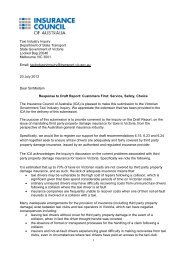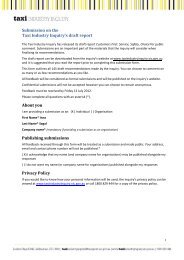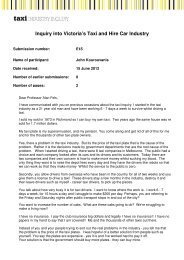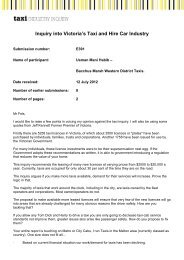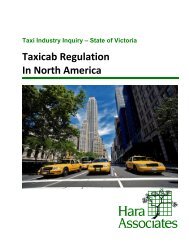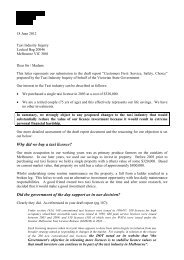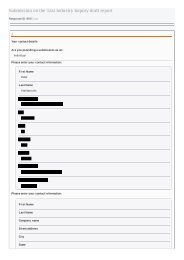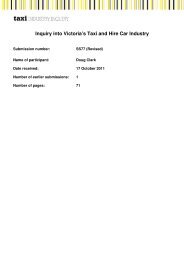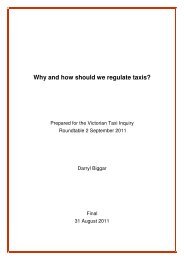Part D â Understanding and improving industry performance (PDF ...
Part D â Understanding and improving industry performance (PDF ...
Part D â Understanding and improving industry performance (PDF ...
You also want an ePaper? Increase the reach of your titles
YUMPU automatically turns print PDFs into web optimized ePapers that Google loves.
A key issue for the inquiry has been to determine whether<br />
the outer suburban zone is causing significant detriments<br />
for taxi operators <strong>and</strong> for consumers. As discussed<br />
above, there are a number of sources of potential costs<br />
from zoning:<br />
Figure 10.6 Identification of trips between metropolitan <strong>and</strong><br />
outer suburban zones<br />
Maps 1 <strong>and</strong> 2: Frankston <strong>and</strong> D<strong>and</strong>enong ‘meter offs’<br />
• First, operators within the outer suburban <strong>and</strong><br />
metropolitan zones may suffer from zoning restrictions<br />
due to increased ‘dead running’.<br />
• Second, consumers may be harmed because of<br />
potential service refusals from drivers who attempt to<br />
minimise ‘dead running’.<br />
• Finally, consumers may suffer further if the response<br />
of the regulator to operator inefficiency caused by<br />
zoning is to restrict licences further to maintain service<br />
viability. On the other h<strong>and</strong>, it is arguable that there<br />
may be some benefits from a higher level of service<br />
provided within the zone compared to if the zone is<br />
removed <strong>and</strong> there are very different licence values<br />
between the two merged zones.<br />
The inquiry has sought evidence on these points.<br />
Dead running costs from the zoning restriction may be<br />
measured by considering the following data:<br />
• The number of trips that start in the outer suburban<br />
zone <strong>and</strong> finish in the metropolitan zone.<br />
• The number of trips that start in the metropolitan zone<br />
<strong>and</strong> finish in the outer suburban zone.<br />
The extent of the cost involved for operators will depend<br />
upon the frequency of these trips <strong>and</strong> the distance the<br />
trip terminates from the zone boundary. Consumers<br />
also bear a cost, because they would have greater taxi<br />
availability in the metropolitan zone if the outer suburban<br />
taxi was allowed to pick up a fare from the point where<br />
the last fare finished (<strong>and</strong> vice versa).<br />
Frankston<br />
2011 Q1 & Q2 Meter Off Count<br />
250m x 250m grid squares<br />
#<br />
Taxi Zone Boundary<br />
Meter Count<br />
5,000 plus<br />
1,000 to 5,000<br />
500 to 1,000<br />
250 to 500<br />
100 to 250<br />
50 to 100<br />
25 to 50<br />
10 to 25<br />
1 to 10<br />
Revision Date: 5/4/2012<br />
Map Reference: 615-4-1<br />
Department of<br />
Transport<br />
Policy & Communications Division<br />
© The State of Victoria, Department of Transport, 2012. The<br />
State of Victoria does not warrant the accuracy or completeness<br />
of information in this publication <strong>and</strong> any person using or relying<br />
upon such information does so on the basis that the State of<br />
Victoria shall bear no responsibility or liability whatsoever for<br />
any errors, faults, defects or omissions in the information.<br />
The inquiry’s trip data provides a source of information on<br />
the extent of these costs. Spatial data on trips between<br />
the metropolitan <strong>and</strong> outer suburban zones is highlighted<br />
in Figure 10.6.<br />
Red areas have higher trip frequencies – from light (least<br />
frequent) to dark (most frequent)<br />
Source: TII analysis of Frankston <strong>and</strong> D<strong>and</strong>enong NSP data 2011<br />
Each of these maps indicates that a significant number of<br />
trips finish outside of the zone in which the trip began.<br />
210





